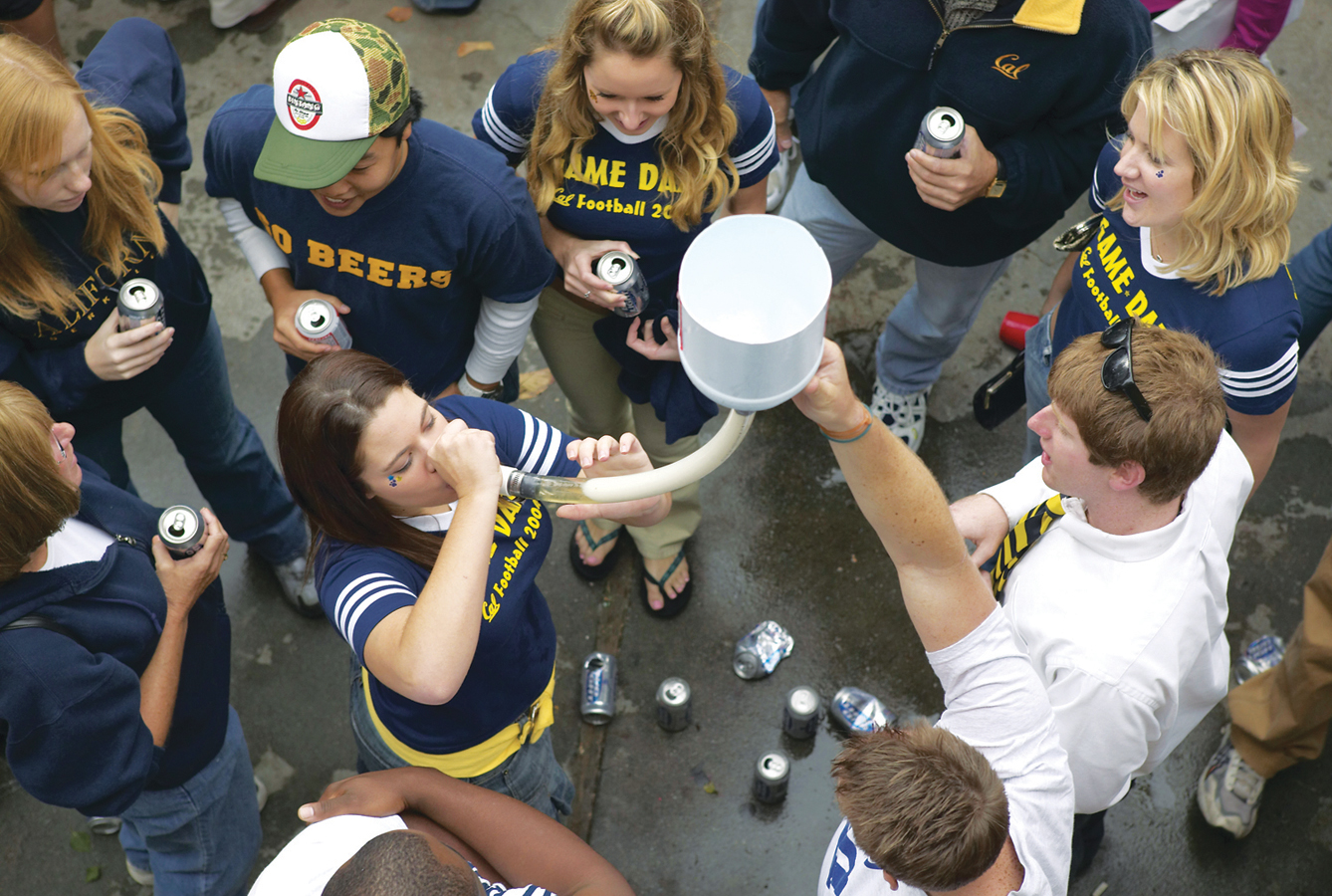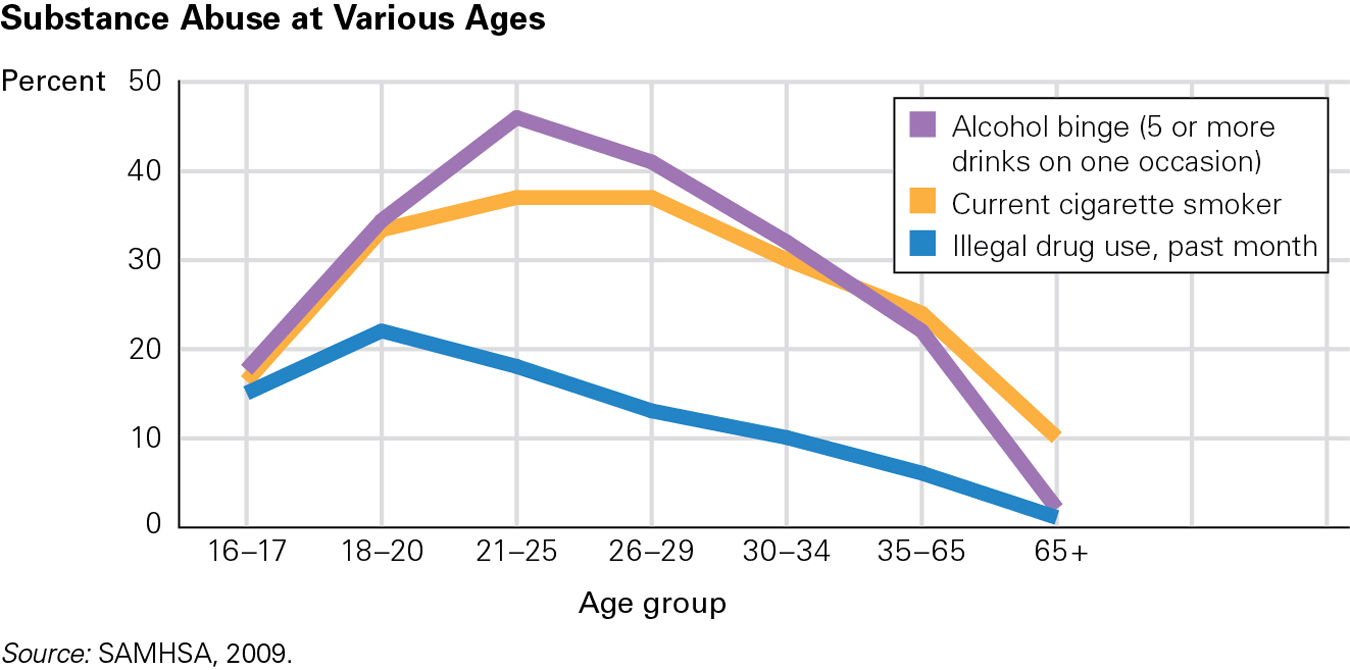11.1 Biosocial Development

Biologically, the years from ages 18 to 25 are prime time for hard physical work and successful reproduction. However, the fact that young adults can carry rocks, plow fields, and reproduce more easily than older adults is no longer universally admired.
If a contemporary young couple had a baby every year, their neighbours would be more surprised than approving. In fact, large families have become so unusual that they are sometimes the focus of TV reality shows. Today, during emerging adulthood, societies, families, and young adults themselves expect more education, later marriage, and fewer children than was true as recently as 50 years ago (see At About This Time). More people are pursuing post-
Following Certain Patterns, by Average Age:
| Age 17- |
Graduate from high school (about 74 percent graduate*) |
| Age 18- |
Enrol in college or university (about 79 percent enrol†) |
| Age 22 | Earn college or university degree (about 53 and 65 percent graduate from universities and colleges, respectively†) |
| Age 25 | Steady employment in chosen field (rate fluctuates, depends on economy) |
| Age 28 | Women’s first child (for those who will have children‡; about 20 percent will not) |
| Age 29 | Women’s first marriage§ |
| Age 31 | Men’s first marriage§ |
|
*Council of Ministers of Education, Canada, 2008. †Statistics Canada, 2008b. ‡Employment and Social Development Canada, n.d.[a]. §Employment and Social Development Canada, n.d.[c]. |
|
Strong and Active Bodies

Health does not change significantly in early adulthood, except maybe to improve with advanced technology and research. Every human body system—
Specifics confirm the health of emerging adults. Serious diseases are usually not yet apparent, and some childhood ailments are outgrown. For example, childhood asthma disappears as often as it continues. Although many emerging adults continue the poor health habits they had as adolescents, the trend is toward better diets and regular exercise, and that improves mental as well as physical health (Walsh, 2011).
However, this does not mean that serious health problems from childhood disappear or that new health concerns do not emerge. A comprehensive review of many studies finds that low birth weight, undernutrition in infancy, and rapid weight gain in early childhood tend to result in shorter height, reduced body functioning, and higher risk of disease in early adulthood (Victora et al., 2008). In a Canadian survey in which only 5.8 percent of young adults rated their health as fair or poor, 9.7 percent reported they had asthma, 2.5 percent said they had arthritis, 2.1 percent had high blood pressure, and 0.9 percent had diabetes. In addition, 7.7 percent had moderate or severe pain or discomfort, and 8.9 percent had pain or discomfort that prevented activities (Statistics Canada, 2013k).
Fortunately, severe health problems are usually kept in check during early adulthood, when the immune system is strong (Grubeck-
397
For most emerging adults, teeth have no new cavities, heart rate is steady, the brain functions well, and lung capacity is sufficient. Many diagnostic tests, such as PSAs (for prostate cancer), mammograms (for breast cancer), and colonoscopies (for colon cancer) are not usually recommended until decades later, unless risk factors are present. Death from any disease is rare, although, as discussed later, death from accidents, suicide, and homicide increase, and psychosocial problems may occur.
Fertility, Then and Now

Dramatic fertility shifts have been observed around the world over the past 50 years. For example, average births per woman over this time period declined from 7 to 1.5 in Iran, 8 to 4 in Kenya, 6 to 2 in South America, and 5 to 1.5 in East Asia. For the world as a whole, the birth rate from 1960 to 2010 fell from 4.9 to 2.45 (United Nations, 2011). Similarly, Canada’s fertility rate in 2011 was 1.63, a significant decrease from 3.81 in 1960, and the lowest rate in North America (see Figure 11.1).

The sexual-
Delaying PregnancyMany emerging adults who have sex know that they are not prepared for parenthood, mentally, emotionally, or financially, and use contraception to avoid pregnancy. Although no contraception is always successful, long-
Largely as a result of the use of contraception, the birth rate has fallen—
Sexually Transmitted InfectionsAs mentioned in Chapter 10, sexually transmitted infections are on the rise worldwide, with half of all new cases occurring in people younger than 26 (Gewirtzman et al., 2011). In Canada in 2008, the highest rates of all types of infections were found in those younger than age 30 (Public Health Agency of Canada, 2008). This trend is also seen in the United States, Australia, and the United Kingdom.
398
ESPECIALLY FOR Nurses When should you discuss the possibility of an STI with a patient? 
Always. Maintain a professional, rather than judgmental, attitude, and be aware that education, gender, self-confidence, and income do not necessarily mean that a given patient is free of an STI. 
Young adults are the prime vectors (those who spread disease) for HIV/AIDS as well. The Public Health Agency of Canada reports that HIV is acquired primarily by men having sex with men (46.7 percent), by use of infected needles (16.9 percent), and through heterosexual contact with those from a non-
Beginning in emerging adulthood, rates of HIV diagnosis/people living with HIV begin to increase. Between 1985 and 2012, about 26 percent of positive HIV tests in Canada were for males under the age of 29 years, and about 37 percent were for females of that same age group (PHAC, 2012a).
It is important to note that the majority of positive HIV test reports are for those over the age of 30. In addition, since 2010, the AIDS epidemic has been slowing, largely because young people are protecting themselves against HIV (World Health Organization [WHO] UNAIDS, 2011). Protection includes fewer sex partners, later sex, more condom use, provision of sterile needles to intravenous drug users, and voluntary circumcision among young adult men (WHO UNAIDS, 2011).
Taking Risks
Remember that each developmental period brings gains and losses, and any specific age-
Benefits and LiabilitiesSocieties, as well as individuals, benefit from this characteristic of emerging adults. Enrolling in college or university, moving to a new city or country, getting married, having a baby—
Yet risk taking is often destructive. Although their bodies are strong and their reactions quick, emerging adults have more accidents that send them to emergency rooms than do people of any other age (except for falls in the elderly). Because of their good overall health, usually they are stitched, casted, medicated, stabilized, and discharged in short order.
The low rate of serious disease between ages 18 and 25 is counterbalanced by a high rate of severe injuries and violent deaths, with males at least twice as vulnerable as females. (Sometimes the ratio is as high as 5 : 1, depending on which nation and which type of violent death is analyzed.) For both sexes, age is always a factor in suicide, self-
- unprotected sex with a new partner
- driving fast without a seat belt
- abusing drugs
- addictive gambling.
399
People behave this way partly for the rush of adrenalin (Cosgrave, 2010). Ironically, warning emerging adults about the risks may lead to a backlash—
Risky SportsMany young adults seek the rush of risk taking in recreational activities. They climb mountains, swim in oceans, run in pain, play past exhaustion, and so on. Skydiving, bungee-
Competitive extreme sports (such as freestyle motocross—riding a motorcycle off a ramp, catching “big air,” doing tricks while falling, and hoping to land upright) are thrilling for some emerging adults. They find golf, bowling, and so on too tame (Breivik, 2010). As one researcher concluded about dirt-
This is clearer with an example. Travis Pastrana won the 2006 X Games MotoX Freestyle event at age 22 with a double backflip because, as he explained, “The two main things are that I’ve been healthy and able to train at my fullest, and a lot of guys have had major crashes this year” (Higgins, 2006, D7). Four years later, in 2010, he set a new record for leaping through big air in an automobile, driving over the ocean from a ramp on the California shore to a barge more than 76 metres out. He crashed into a barrier on the boat, emerging ecstatic and unhurt, to the thunderous cheers of thousands of other young adults (Roberts, 2010). In 2011, a broken foot and ankle made him temporarily halt extreme sports—

Drug AbuseThe same impulse that is admired in extreme sports can lead to behaviours that are clearly destructive, not only for individuals but for the community. The most studied of these is drug abuse, which can involve dozens of substances—

400
By definition, drug abuse occurs whenever a person uses a drug that harms physical, cognitive, or psychosocial well-
More often, abusers are also addicts: They need the drug to feel okay, and they become chronic users. Drug addiction and abuse are more common during emerging adulthood than at any other age (Johnston et al., 2010). Part of the attraction of drugs for this age group is in their abuse, specifically in taking a drug to feel dizzy, out-

ESPECIALLY FOR Substance Abuse Counsellors What three possible explanations can you think of for the more precipitous drop in the use of illegal drugs compared with legal ones? 
Legal drugs could be more addictive, or the thrill of illegality may diminish with age, or the fear of arrest may increase. In any case, treatment for young-adult substance abusers may need to differ from that for older ones. 
Surprisingly, drug abuse is more common among college and university students than among their contemporaries who are not in post-
KEY Points
- Young adults are usually healthy and at peak reproductive potential.
- Many emerging adults use a form of contraception to avoid pregnancy.
- Sexually transmitted infections are more common among emerging adults.
- Emerging adults are risk takers, sometimes risking their life.
- Drug abuse and addiction are more common during emerging adulthood than in any other period.
401